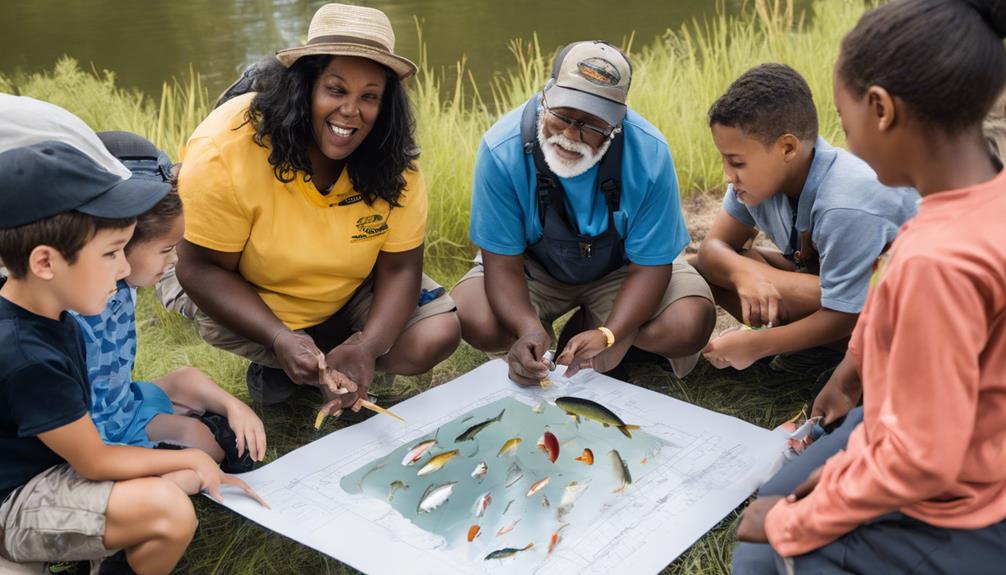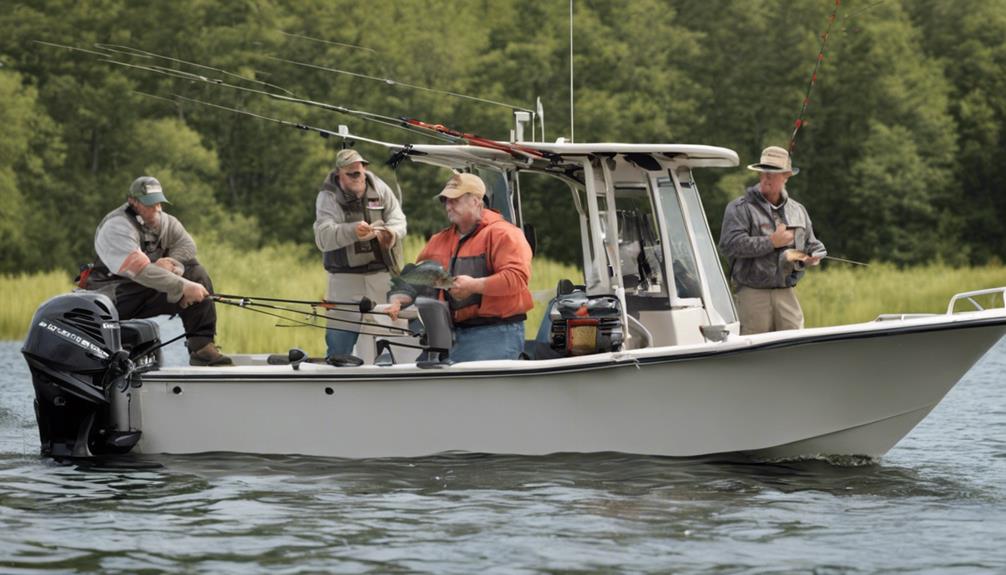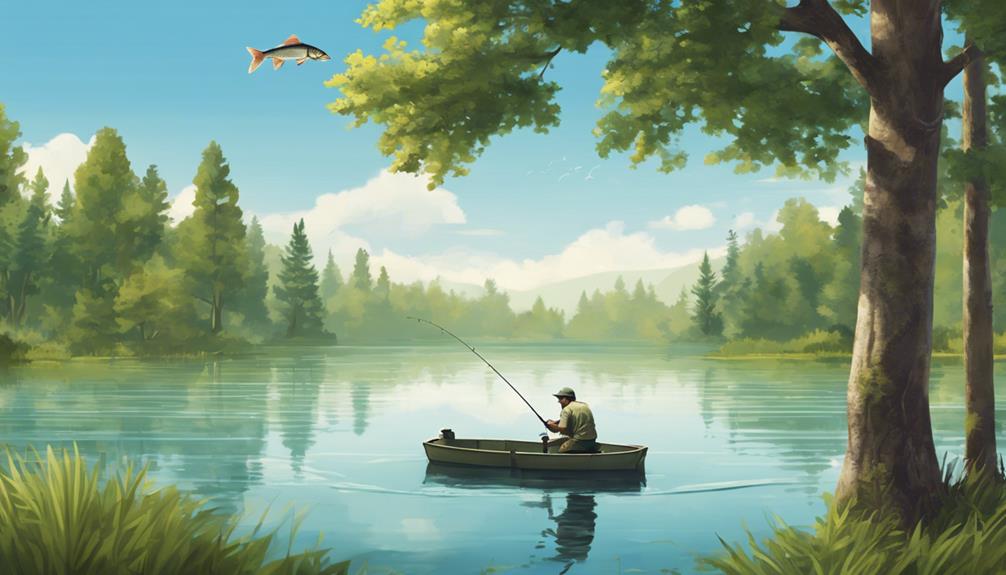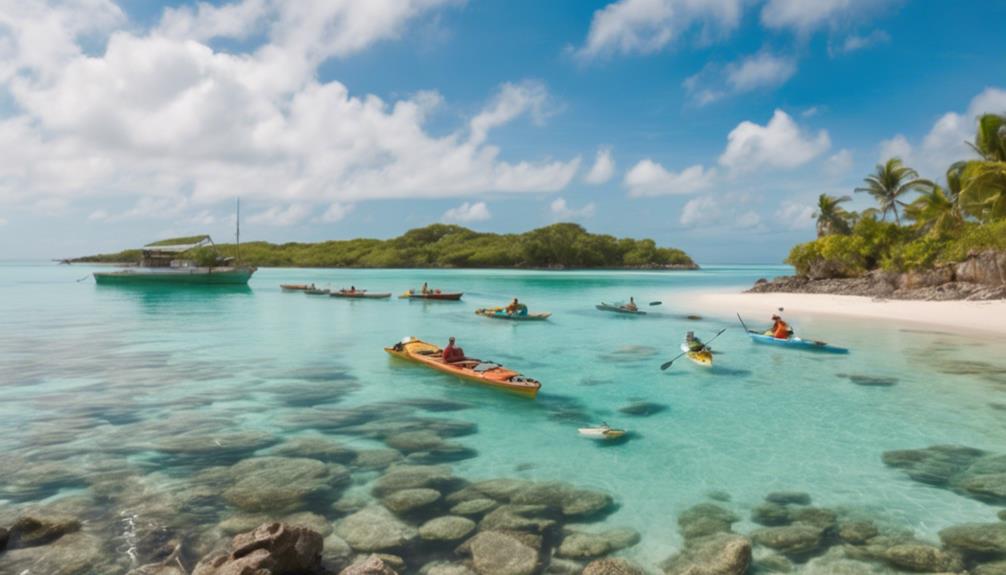Embark on an exploration of effective and engaging local fishing conservation initiatives that are shaping the future of our aquatic environments.
From innovative community projects to governmental regulations, there is a myriad of strategies at play to ensure the sustainability of our fisheries. Discover how these diverse efforts come together to safeguard marine ecosystems and support the livelihoods of fishing communities.
Stay tuned to unravel the intricate web of conservation actions that are making a tangible difference in preserving our oceans for generations to come.
Importance of Local Fishing Conservation
To protect the marine ecosystem and ensure sustainable fish populations, local fishing conservation is crucial. Marine biodiversity thrives when fishing practices are sustainable. By regulating fishing activities, local conservation efforts play a vital role in maintaining the delicate balance of marine ecosystems. Overfishing can deplete key species, disrupt food chains, and harm overall ecosystem health. Local fishing conservation initiatives help prevent these negative impacts and promote the long-term health of our oceans.
When marine biodiversity is preserved, it benefits not only the fish populations but also other marine organisms. Each species plays a unique role in the ecosystem, and a decline in one can have cascading effects on the entire habitat. By focusing on local fishing conservation, communities can work together to protect these intricate relationships and maintain a healthy balance within the marine environment.
Ecosystem health relies on the sustainability of fishing practices. Overfishing can lead to population declines, habitat degradation, and ecosystem imbalances. Through local fishing conservation efforts, communities can mitigate these risks and ensure that marine ecosystems remain resilient and productive. By actively participating in conservation initiatives, individuals can contribute to the overall health and well-being of our oceans for present and future generations.
Key Players in Conservation Efforts
Key conservation efforts in local fishing initiatives involve various stakeholders working collaboratively to safeguard marine biodiversity. These key players include government agencies, non-profit organizations, local communities, and industry partners. Government agencies play a crucial role in setting regulations and policies to ensure sustainable fishing practices. They provide oversight and enforcement to protect marine ecosystems and species.
Non-profit organizations are instrumental in driving conservation efforts through research, advocacy, and community engagement. They often collaborate with government agencies and local communities to implement conservation projects and raise awareness about the importance of marine conservation. These organizations also play a vital role in securing funding opportunities to support conservation initiatives.
Local communities are key players in conservation efforts as they rely on marine resources for their livelihoods. By promoting sustainable fishing practices and participating in conservation projects, communities can help protect marine biodiversity for future generations. Engaging with local stakeholders through partnerships and outreach programs is essential to ensure the success of conservation initiatives.
Industry partners, including fishing companies and seafood retailers, also play a significant role in conservation efforts. By adopting sustainable fishing practices and supporting conservation projects, industry partners can contribute to the preservation of marine ecosystems. Collaborating with these partners can provide additional funding opportunities for conservation initiatives, helping to ensure their long-term success.
Sustainable Fishing Practices
In order to ensure the long-term health of marine ecosystems, implementing sustainable fishing practices is essential for all stakeholders involved in local fishing conservation initiatives. By adopting ethical sourcing and fishing methods, you can play a crucial role in preserving marine biodiversity and safeguarding the livelihoods of future generations.
Here are some key practices to consider:
- Selective Fishing: Target only specific species to prevent bycatch and minimize environmental impact.
- Regulated Fishing Seasons: Adhere to fishing schedules to allow marine populations to reproduce and replenish.
- Gear Modification: Use gear that reduces habitat destruction and minimizes the capture of non-targeted species.
- Size Limits: Respect size limits to ensure that fish have a chance to reproduce before being caught.
- Support Sustainable Practices: Choose seafood from sources that follow sustainable fishing methods to promote responsible harvesting and consumption.
Community-Based Conservation Projects
Engage with local communities to foster collaborative conservation efforts aimed at protecting marine ecosystems and sustaining fishing resources. By promoting grassroots involvement and establishing strong community partnerships, you can initiate impactful community-based conservation projects that focus on ecosystem restoration and habitat protection.
One effective approach is to work closely with local stakeholders, such as fishers, conservation groups, and government agencies, to develop and implement conservation initiatives. Through active engagement and participation, community members become invested in the preservation of their natural resources, leading to more sustainable fishing practices and enhanced ecosystem resilience.
Community-based projects often center around ecosystem restoration efforts, such as mangrove reforestation, coral reef rehabilitation, and seagrass bed protection. These initiatives not only help to conserve critical habitats but also support biodiversity and improve overall marine ecosystem health.
Furthermore, habitat protection plays a vital role in maintaining fish populations and ensuring long-term fishing sustainability. Collaborating with communities to establish marine protected areas, implement sustainable fishing regulations, and monitor resource usage can significantly contribute to the conservation of fish stocks and the preservation of local fishing traditions.
Through community-based conservation projects that prioritize grassroots involvement and foster strong community partnerships, you can make a tangible difference in safeguarding marine ecosystems and securing fishing resources for future generations.
Monitoring and Research Initiatives
To advance the conservation efforts and ensure the sustainability of local fishing resources, the implementation of robust monitoring and research initiatives is critical. By collecting data and conducting scientific studies, valuable insights can be gained to inform effective conservation strategies and protect marine ecosystems. Here are some key elements of monitoring and research initiatives:
- Underwater Cameras: Deploying underwater cameras in fishing areas to observe fish populations and behaviors in their natural habitat.
- Tagging Programs: Implementing tagging programs to track the movements of fish species and understand their migration patterns.
- Water Quality Testing: Conducting regular water quality testing to assess the health of aquatic environments and detect any signs of pollution.
- Fish Population Surveys: Conducting fish population surveys to estimate population sizes, monitor trends, and identify any declines that may require intervention.
- Collaborative Research: Partnering with local universities or research institutions to conduct collaborative research projects that deepen our understanding of local marine ecosystems.
Through these monitoring and research initiatives, local communities can work together to gather valuable data, conduct scientific studies, and make informed decisions to promote the long-term sustainability of fishing resources.
Government Regulations and Policies
How do government regulations and policies impact local fishing conservation efforts?
Government oversight plays a crucial role in ensuring the sustainability of fish populations and the overall health of aquatic ecosystems. By implementing regulations and policies, authorities aim to manage fishing activities, protect endangered species, and prevent overfishing. These regulations often dictate catch limits, fishing seasons, gear restrictions, and protected areas to promote conservation.
To effectively contribute to conservation efforts, it's essential for local fishermen to comply with these regulations and policies. Policy compliance is key to maintaining the delicate balance of marine environments and preserving fish stocks for future generations. By adhering to set guidelines, fishermen can help prevent the depletion of fish populations and promote sustainable fishing practices.
Government regulations also serve to address broader environmental concerns, such as habitat destruction and pollution. By enforcing rules that limit harmful fishing practices and promote responsible stewardship of natural resources, authorities strive to mitigate the negative impacts of human activities on marine ecosystems.
Conservation Education and Outreach

Government regulations and policies lay the foundation for effective conservation education and outreach efforts within local fishing communities. To ensure the success of conservation initiatives, it's crucial to engage in outreach programs and awareness campaigns that educate both fishermen and the general public. Here are some key strategies to enhance conservation education and outreach:
- Workshops and Seminars: Conduct regular workshops and seminars to educate fishermen about sustainable fishing practices and the importance of marine conservation.
- Collaboration with Schools: Partner with local schools to incorporate conservation education into their curriculum, fostering a sense of responsibility towards the environment from a young age.
- Community Events: Organize community events such as beach clean-ups or fishing tournaments with a conservation message to raise awareness among the public.
- Social Media Campaigns: Utilize social media platforms to reach a wider audience and spread information about conservation efforts and ways the community can get involved.
- Interactive Field Trips: Arrange field trips to marine conservation centers or local ecosystems to provide hands-on learning experiences for both children and adults.
Success Stories in Conservation
In highlighting success stories in conservation efforts, local fishing communities have showcased remarkable achievements in preserving marine ecosystems and sustaining fish populations. Through conservation partnerships and grassroots impact, these communities have implemented collaborative initiatives that have led to significant improvements in the health of marine habitats and the abundance of fish stocks. By working together with local stakeholders, such as government agencies, conservation organizations, and scientific researchers, these fishing communities have been able to establish sustainable practices that benefit both the environment and their livelihoods.
Additionally, the integration of conservation technology and data-driven solutions has played a crucial role in the success of these initiatives. By utilizing tools such as GPS tracking, underwater drones, and big data analysis, local fishing communities have been able to monitor and manage their activities more effectively. This has allowed them to make informed decisions that minimize their impact on the marine environment while maximizing their catch efficiency.
Frequently Asked Questions
Can Individuals Participate in Local Fishing Conservation Initiatives Even if They Don't Live Near a Body of Water?
You can still get involved in local fishing conservation initiatives even if you're not close to water. Remote participation and virtual volunteering opportunities allow you to contribute from anywhere.
Engage in community outreach and educational workshops to support conservation efforts and make a difference. By spreading awareness and promoting sustainable practices, you can play a crucial role in protecting aquatic ecosystems, even if you live far from a body of water.
How Do Local Fishing Conservation Efforts Impact the Overall Health of Aquatic Ecosystems?
Local fishing conservation efforts play a crucial role in preserving aquatic ecosystems. By promoting sustainability practices and engaging communities in biodiversity conservation, these initiatives help maintain the health of our water environments.
Through active involvement and responsible fishing practices, individuals can contribute to the overall well-being of aquatic ecosystems and ensure a sustainable future for all species that rely on these delicate habitats.
What Are Some Innovative Technologies Being Used to Monitor and Research Fish Populations in Local Waters?
To monitor fish populations in local waters, innovative technologies like satellite tracking and underwater drones are being used. These tools provide valuable data on fish movement and behavior.
Genetic sampling and acoustic telemetry help researchers gather information on fish genetics and migration patterns.
Are There Any Specific Challenges Faced by Marginalized Communities in Participating in Fishing Conservation Projects?
When it comes to participating in fishing conservation projects, marginalized communities often face unique challenges. These can include limited access to resources, lack of representation in decision-making processes, and historical injustices that affect their ability to engage fully.
Overcoming these obstacles requires tailored approaches that prioritize inclusivity, equitable opportunities, and proactive outreach efforts. By addressing these challenges head-on, we can ensure that all individuals have a meaningful role in conservation initiatives.
How Can Tourists and Visitors Contribute to Local Fishing Conservation Efforts in Areas They Are Visiting?
When you travel to new places, you can support local fishing conservation efforts by engaging in eco-friendly tourism. Choose sustainable practices like using responsible tour operators and consuming seafood from sustainable sources.
Engage with local communities through volunteer opportunities to learn about their conservation initiatives and contribute to their efforts. Your involvement can help protect marine ecosystems and support the livelihoods of those who depend on fishing for their way of life.
Conclusion
Overall, participating in local fishing conservation initiatives is vital to maintaining healthy aquatic ecosystems and preserving fish populations for future generations.
By working together with key players, implementing sustainable practices, supporting community projects, conducting research, adhering to regulations, and educating others, we can make a significant impact on the health of our oceans and waterways.
Remember, every small effort counts towards the bigger goal of sustainable fishing and conservation.



